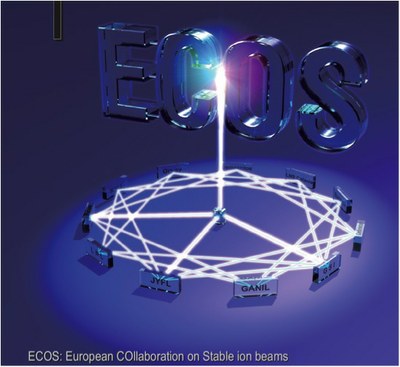What is ECOS?
Network NA02
|
!!NEW!! ECOS Chart of Stable Beams |
The ECOS (European COllaboration on Stable ion beams) working group has been appointed by NuPECC in 2004 with the following tasks:
|
The ECOS working group has prepared a report which is available at the NuPECC web pages and which has been published in 2007. One of the important recommendations of the ECOS working group is to ensure a strong support from both the nuclear-physics community and the funding agencies for existing stable-ion-beam facilities not only for their accelerator-system development but also for the instrumentation and experimental infrastructure needed to host dedicated research programmes. The other important recommendation is that a new dedicated high-intensity stable-ion-beam facility in Europe, with energies at and above the Coulomb barrier, is considered to be one of the important issues to be discussed in the Long-Range Plan of the nuclear-physics community.
The objectives of the proposed ECOS-Network are related to these two recommendations and they are twofold:
- Bring together and coordinate the expertise that is available in the European countries in order to achieve the research and development activities in essential aspects related to the production and use of high-intensity heavy-ion beams (Task 1). The important aspect related to the development of high-power ion sources is the objective of JRA01-ARES with which the NA02-ECOS will have a significant synergy.
- Optimise resources and manpower for the upgrade and development of various stable-ion-beam facilities in Europe in order to optimise their scientific output (Tasks 2 and 3).
Task 1 High-power thin-target technology (participants: CNRS, GANIL, GSI)
The maximum usable primary-beam current with thin targets is among others determined by the long-term stability of the thin targets under irradiation. High beam intensities lead to a considerable heating of the targets, and, hence to thermal stress, possibly phase transitions, oxidation or reduction of the chemical compounds and diffusion into the target backing, respectively.We propose to study these phenomena in detail and to compare for example the performance of thin actinide targets as function of the production method (painting, spray-painting, electrolysis, electrodeposition, evaporation and sputtering), the used chemical compounds (oxide, carbide, others) and backings/coatings, respectively. The way is to bring together labs that use different techniques for target preparation and those that can test the target performance under “real” conditions.
For this task ECOS will have the duty to organise the collaboration and exchange of expertise on the development of high-power target technology.
Task 2 Synergies in Super-Heavy Element Research (participant: GSI, GANIL, JYU)
The study of Super-Heavy Elements (SHE) is one of today’s most challenging interdisciplinary research fields. It brings together nuclear physics, atomic physics, chemistry and theoretical physics. Over the last years, researchers from the different disciplines have continued to strengthen exchange of ideas. The ECOS community proposes to use this Network in order to enhance synergies among the research groups on a European scale.For this task ECOS is aiming for bringing together the groups with research activities on SHE using high-intensity ion beams for exchange of new ideas and techniques related to the use of very high-intensity stable beams.

